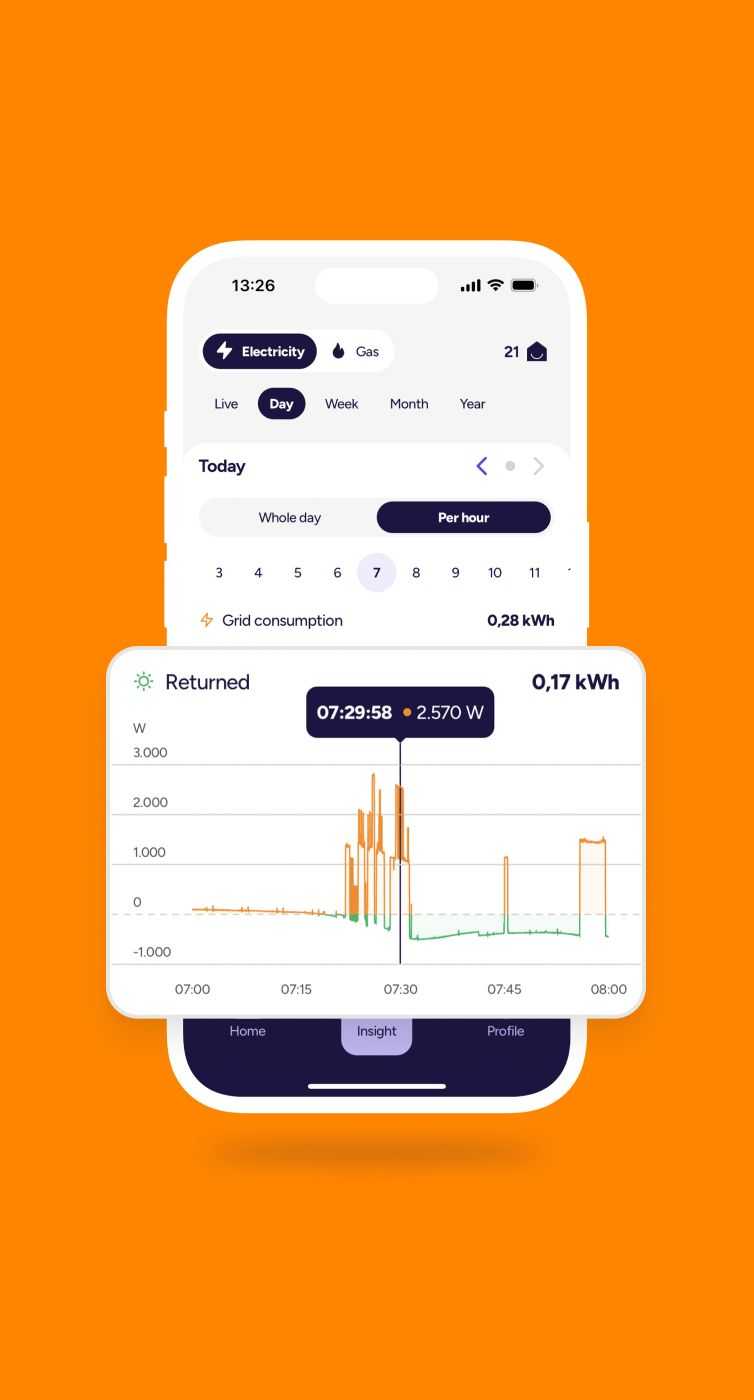If you're somewhat aware of your energy consumption, you probably know that it's quite difficult to estimate whether you're using a lot or a little energy. What is considered ‘normal’ consumption for a household? And how can you ensure that your consumption is balanced with your savings goals? More and more households are consuming less energy, for example, by better insulation or the use of solar panels. At Chargee, we help you gain insight into your energy consumption so you can save smarter and make sustainable choices. On this page, you'll learn what the average energy consumption in the Netherlands is and which factors influence it. For example: the size of your family, the type of home you live in, and whether you use energy-efficient appliances.
What is average energy consumption?
An average household in the Netherlands usually consists of 2 or 3 people. The average energy consumption for such a household is 2,640 kWh of electricity and 1,110 m³ of gas per year. This is an estimate, as actual consumption may vary. Your actual consumption depends on several factors, such as:
- the size of your home: an apartment typically uses less energy than a large detached house.
- how (well) your home is insulated: a well-insulated home naturally requires less energy to warm up.
- which appliances you use: if you have many energy-hungry devices, your consumption may be higher. For example, an electric car is a major energy consumer.
- whether you have solar panels: using solar power results in lower (net) electricity consumption.
- whether you have a heat pump: such a heat pump reduces gas consumption but increases electricity consumption.
An interesting trend we’ve seen in recent years is a decline in electricity consumption. This is due to the increasing use of more efficient appliances, such as energy-efficient refrigerators, washing machines, and LED lighting. But there’s still much more to gain if you better understand your energy consumption.
This is the average energy consumption per household
Your energy consumption naturally depends on the composition of your household. Do you live with 4 other students in a student house? Or do you live alone (with a cat?) in a studio? Then your consumption is likely different. Are you curious about the average energy consumption for your household? Let's take a look at the average energy consumption per household, depending on the size of your family:
| Family Composition | Electricity Consumption (kWh/year) | Gas Consumption (m³/year) | Total Cost (€/month) |
|---|---|---|---|
| 1 person | 1,500 | 600 | €115.00 |
| 2 people | 2,100 | 800 | €156.67 |
| 3 people | 2,500 | 950 | €186.25 |
| 4 people | 2,800 | 1,100 | €212.50 |
| 5 or more people | 3,100 | 1,250 | €238.75 |
As you can see, electricity and gas consumption increases as the household size grows. Additionally, many other factors influence your consumption, such as the type of appliances you use, whether you have an energy-efficient home, and how often you turn on the heating.
Average energy consumption per housing type
The type of home you live in also affects your energy consumption. The larger your home, the more energy you are likely to use. This is because larger homes usually require more heating and cooling. Additionally, how well your home is insulated plays a big role. For example, well-insulated homes can save 30–40% on gas consumption compared to poorly insulated homes. We also see that poorly insulated homes can be €50 to €100 more expensive in energy costs per month. Take a look at the following:
| Housing Type | Energy Label | Electricity Consumption (kWh/year) | Gas Consumption (m³/year) | Total Cost (€/month) |
|---|---|---|---|---|
| Apartment | A/B (well insulated) | 1,600 | 500 | €107.50 |
| Apartment | C/D (moderately insulated) | 1,900 | 700 | €139.17 |
| Apartment | E/F/G (poorly insulated) | 2,200 | 1,000 | €181.67 |
| Terrace House | A/B (well insulated) | 2,200 | 750 | €154.58 |
| Terrace House | C/D (moderately insulated) | 2,500 | 900 | €180.83 |
| Terrace House | E/F/G (poorly insulated) | 2,800 | 1,200 | €223.33 |
| Corner House | A/B (well insulated) | 2,400 | 850 | €172.08 |
| Corner House | C/D (moderately insulated) | 2,700 | 1,000 | €198.33 |
| Corner House | E/F/G (poorly insulated) | 3,000 | 1,300 | €240.83 |
| Semi-Detached House | A/B (well insulated) | 2,600 | 950 | €189.58 |
| Semi-Detached House | C/D (moderately insulated) | 2,900 | 1,100 | €215.83 |
| Semi-Detached House | E/F/G (poorly insulated) | 3,300 | 1,500 | €272.50 |
| Detached House | A/B (well insulated) | 2,800 | 1,050 | €207.08 |
| Detached House | C/D (moderately insulated) | 3,100 | 1,200 | €233.33 |
| Detached House | E/F/G (poorly insulated) | 3,500 | 1,700 | €300.83 |
Average energy consumption per month, day, and year
You can also look at your energy consumption over different periods. How much energy do you consume per day, per month, or per year? Your energy consumption in the winter is, of course, quite different from in the summer. By looking at your consumption this way, you gain a better understanding of how much you're actually using and where you might be able to save. Do you have our Sparky P1 meter in your meter cupboard? Then you can easily see what you use each day or month in the Chargee app and where you can save. Here's the average consumption per period:
- Per year: a family of 4 consumes about 2,800 kWh of electricity and 1,100 m³ of gas.
- Per month: this comes down to around 233 kWh of electricity and 92 m³ of gas.
- Per day: this family consumes on average 7.8 kWh of electricity and 3 m³ of gas.
3 practical tips to save energy
Now that you know more about your average energy consumption, you probably want to know how you can save on that consumption. Here are a few handy tips:
Use energy-efficient appliances
Investing in energy-efficient appliances can make a big difference. An energy-efficient fridge, for example, consumes much less electricity than older models. Want to know what to look out for? Check out the tips for detecting high electricity consumption and discover how to reduce your electricity usage.Reduce your standby power consumption
Many appliances still consume energy when they are ‘off’. This is called standby power. By turning appliances completely off – rather than leaving them in standby mode – you can save a few euros per year. Want to learn more? Read all about standby power and how to measure it.Improve your use of solar panels
Do you have solar panels? Then it’s smart to invest in a home battery. This way, you can store the energy you don’t use immediately and use it later. This helps you manage your own energy consumption better and save more. Want to know more? Read about the benefits of a home battery.
How Chargee can help with your energy consumption insights
Have you downloaded the Chargee app yet? With it, you can track your energy consumption live, look back at it, and make a prediction for the future. You can link the app to your solar panels so you can also see how much of your solar energy you’re consuming at home. Plus, you’ll receive personalized saving tips. This way, you can start focusing on reducing your energy consumption. Whether you're at home or lying under a palm tree on a tropical island: you always have access to your energy consumption. We also offer smart meters and other useful tools to help you monitor your energy consumption as efficiently as possible. With this data, you can easily adjust and improve your energy consumption. Ready to get started? Choose Chargee today and see how you can reduce your energy consumption!



